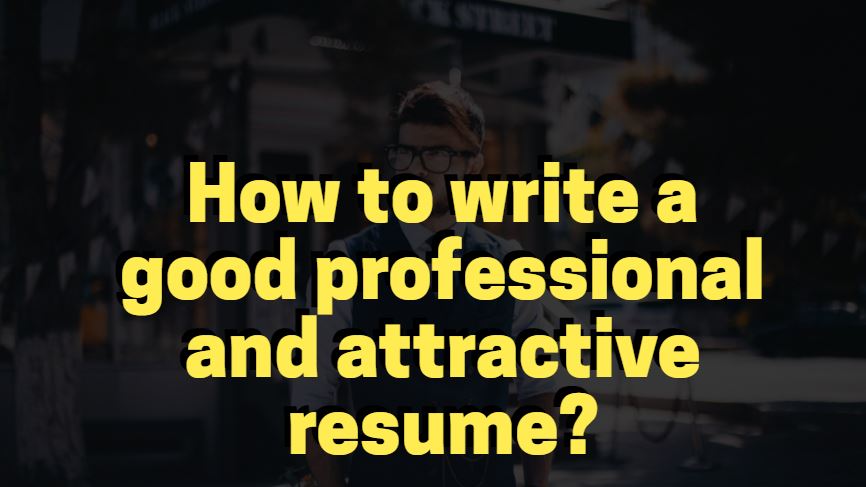How to write a good professional and attractive resume?
Each application file spends an average of twenty seconds in front of the recruiter during its screening. During his twenty seconds, he selects the most polished and attractive documents. So, for your application to stand out from the crowd, it must be captivating and convincing, especially at the level of your Curriculum Vitae.
Writing a CV requires seriousness. It must represent your professionalism. Therefore, it is important to create a folder offering relevant content that highlights your skills and professional backgrounds.
Wondering what a professional resume looks like to recruiters? Discover here the key points to focus on when writing your Curriculum Vitae. Also take advantage of our advice on how to easily land the job of your dreams.
Create an eye-catching CV
 |
| How to write a good professional and attractive resume |
Your CV should stand out from the crowd from the recruiter's first glance. To do this, we recommend that you adopt a neat layout and a well-adapted structure that meets the expectations of your future employer.
A neat layout
Here are the rules for a successful presentation:
- Air your CV with margins of at least 1.15 cm
- Choose a single professional typeface (Arial, Calibri, Garamond ...)
- Respect the font sizes (between 10 and 12 for the body and 14 and 16 for the titles)
- Use bulleted lists when listing
- Include all the important elements of your CV
- Put all the content of your CV on one page
- Harmonize the colors you use on your CV
- Adopt a custom style instead of the standard model
A well-suited structure
The outline of your CV should follow the universal structure of a CV. In fact, a good structure follows a few golden rules in order to bring out the perfect content. This is what the headings should look like in your CV:
- Header (your personal information + photo)
- Introduction or About
- Professional experience
- Education or academic background
- Skills (hard-skills and soft-skills)
- Additional section (interests, hobbies, certification, languages mastered, etc.)
Promote their skills and personal backgrounds
If you want to create a professional and compelling resume, you need to highlight your skills and your personal background. These elements will directly bring out your qualities. Without a doubt, by privileging and valuing these elements, you will succeed in directly capturing the attention of recruiters.
To do this, follow these practical ideas:
- Find out about the position offered by the company
- Reveal your personalities that match the offer
- List your skills and knowledge carefully in two different sections
- List your backgrounds (training and experience) in chronological order
- Indicate only the activities that are related to the position to which you are applying
You can also maximize your chances with additional topics such as certifications, your computer skills, your passions, etc. These other elements are necessary to support your skills and your personal journey.
Choose the best resume template
Most applicants choose professional resume templates without realizing that the resume should match the profile of the job they want to covet. Indeed, this is one of the reasons why recruiters do not contact them for a job interview.
Before writing your CV, you should know that there are 3 main categories of CV: chronological, functional and chrono-functional.
Chronological CV
The purpose of this type of CV is to highlight your career paths chronologically. It starts by mentioning your professional experiences, from the most recent to the oldest, and the same goes for your academic background. The chronological CV highlights your past experiences. This type of format is recommended for experienced people.
Functional CV
Also called thematic CV, this second type of CV aims to showcase your skills and abilities. Unlike the chronological CV, in principle it aims to attract the recruiter's attention through your diploma and your academic background. This format is recommended for people with little experience.
Chrono-functional CV
The latter is the combination of chronological order and functional order. Each section of this template follows chronological order. And the “work experience” section emphasizes the skills and accomplishments of each position. With this format, you can group your skills into a single section or display them in your career path.
In short, the choice of the format of your CV depends on your profile. This way, your CV will be professional and attractive.
Think about your recruiter's expectations
Recruiters, especially in large companies, are looking for a candidate who meets their expectations. Your future employer reviews your resume for their own sake, because if you are not able to know what they expect from you, you will never get a job with them. Tips :
- Make your CV positive by meeting their expectations in the job posting
- Analyze in depth the position you are applying for
- Include in your CV all the knowledge you have acquired that is relevant to the position
- Learn about the company and even its culture
Key points to remember
- Opt for a neat layout and a well-suited structure.
- Highlight your skills and personal backgrounds
- Choose the best format corresponding to your profile
- Meet the requirements of your future position
- Proofread your CV and change words that are unprofessional
The CV is an essential element for anyone looking for a job. Without a professional and attractive CV, recruiters will reject your application within 20 seconds. Don't forget to highlight your personal and professional journey. Finally, no spelling mistakes should appear on your CV.
Commentaires
Enregistrer un commentaire